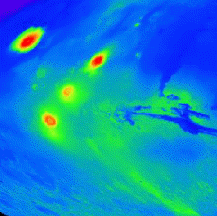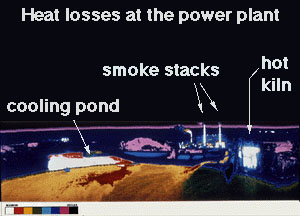Exploratour - The Surface of Mars
Click on image for full size
Image from: NASA
Volcanoes
Mars is populated with many volcanoes, and the Tharsis Ridge is the home of several of those volcanoes, including Olympus Mons.
On this map of Mars, the Tharsis Ridge is shown, as well as the Martian highlands (near the bottom of the picture), and Valles Marineris to the right. The volcanoes are the yellow and red dots in the sea of blue in this image.
Olympus Mons is the leftmost volcano in the image. The three large volcanoes which accompany Olympus Mons on the Tharsis Ridge are Arsia Mons, Pavonis Mons, and Ascraeus Mons. Other volcanoes named Tharsis Tholus, Ceraunius Tholus, Elysium Mons, and Albov Tholus are found in the right-hand side of the large topographic map of Mars on page 3 of this tour, as well as the high resolution version of the map to the left (found by clicking on it).












